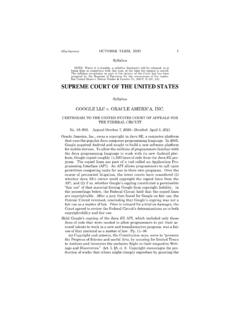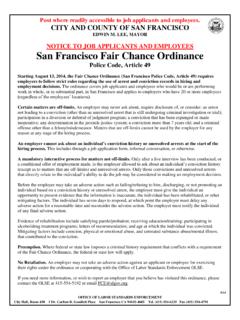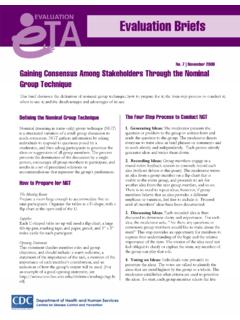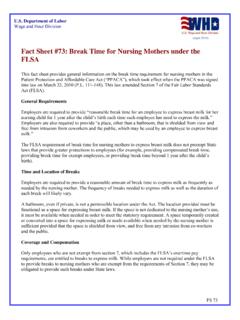Transcription of Code of FairTesting Practices inEducation
1 code of fair testing fair testing Practices in Education CONTENTS. 4 Developing and Selecting Appropriate Tests 6 Administering and Scoring Tests 8 Reporting and Interpreting Test Results 10 Informing Test Takers 11 Working Group T he code of fair testing Practices in Education ( code ) is a guide for professionals in fulfilling their obligation to provide and use tests that are fair to all test takers regardless of age, gender, disability, race, ethnicity, national origin, religion, sexual orientation, linguistic background, or other personal characteristics. Fairness is a primary consideration in all aspects of testing . Careful standardization of tests and administration conditions helps to ensure that all test takers are given a comparable opportunity to demonstrate what they know and how they can perform in the area being tested.
2 Fairness implies that every test taker has the opportunity to prepare for the test and is informed about the general nature and content of the test, as appropriate to the purpose of the test. Fairness also extends to the accurate reporting of individual and group test results. Fairness is not an isolated concept, but must be considered in all aspects of the testing process. The code applies broadly to testing in education (admissions, educational assessment, educational diagnosis, and student placement) regardless of the mode of presentation, so it is relevant to conventional paper-and-pencil tests, computer-based tests, and performance tests. It is not designed to cover employment testing , licensure or certification testing , or other types of testing outside the field of education.
3 The code is directed primarily at professionally developed tests used in formally administered testing programs. Although the code is not intended to cover tests prepared by teachers for use in their own classrooms, teachers are encouraged to use the guidelines to help improve their testing Practices . The code addresses the roles of test developers and test users separately. Test developers are people and organizations that construct tests, as well as those that set policies for testing programs. Test users are people and agencies that select tests, administer tests, commission test development services, or make decisions on the basis of test scores. Test developer and test user roles may overlap, for example, when a The code has been prepared by the Joint Committee on testing Practices , a cooperative effort among several professional organizations.
4 The aim of the Joint Committee is to act in the public interest to advance the quality of testing Practices . Members of the Joint Committee include the American Counseling Association (ACA), the American Educational Research Association (AERA), the American Psychological Association (APA), the American Speech- Language-Hearing Association (ASHA), the National Association of School Psychologists (NASP), the National Association of Test Directors (NATD), and the National Council on Measurement in Education (NCME). 2. state or local education agency commissions test development services, sets policies that control the test development process, and makes decisions on the basis of the test scores. Many of the statements in the code refer to the selection and use of existing tests.
5 When a new test is developed, when an existing test is modified, or when the administration of a test is modified, the code is intended to provide guidance for this process.*. The code provides guidance separately for test developers and test users in four critical areas: A. Developing and Selecting Appropriate Tests B. Administering and Scoring Tests C. Reporting and Interpreting Test Results D. Informing Test Takers The code is intended to be consistent with the relevant parts of the Standards for Educational and Psychological testing (American Educational Research Association [AERA], American Psychological Association [APA], and National Council on Measurement in Education [NCME], 1999). The code is not meant to add new principles over and above those in the Standards or to change their meaning.
6 Rather, the code is intended to represent the spirit of selected portions of the Standards in a way that is relevant and meaningful to developers and users of tests, as well as to test takers and/or their parents or guardians. States, districts, schools, organizations, and individual professionals are encouraged to commit themselves to fairness in testing and safeguarding the rights of test takers. The code is intended to assist in carrying out such commitments. * The code is not intended to be mandatory, exhaustive, or definitive, and may not be applicable to every situation. Instead, the code is intended to be aspirational, and is not intended to take precedence over the judgment of those who have competence in the subjects addressed.
7 Copyright 2004 by the Joint Committee on testing Practices . This material may be reproduced in its entirety without fees or permis- sion, provided that acknowledgment is made to the Joint Committee on testing Practices . Any exceptions to this, including requests to excerpt or paraphrase this document must be presented in writ- ing to Director, testing and Assessment, Science Directorate, APA. This edition replaces the first edition of the code , which was published in 1988. Please cite this document as follows: code of fair testing Practices in Education. (2004). Washington, DC: Joint Committee on testing Practices . (Mailing Address: Joint Committee on testing Practices , Science Directorate, American Psychological Association, 750 First Street, NE, Washington, DC 20002-4242.)
8 3. Developing and Selecting A Appropriate Tests Test Developers Test developers should provide the information and supporting evidence that test users need to select appropriate tests. 1. Provide evidence of what the test measures, the recommended uses, the intended test takers, and the strengths and limitations of the test, including the level of precision of the test scores. 2. Describe how the content and skills to be tested were selected and how the tests were developed. 3. Communicate information about a test's characteristics at a level of detail appropriate to the intended test users. 4. Provide guidance on the levels of skills, knowledge, and training necessary for appropriate review, selection, and administration of tests.
9 5. Provide evidence that the technical quality, including reliability and validity, of the test meets its intended purposes. 6. Provide to qualified test users representative samples of test questions or practice tests, directions, answer sheets, manuals, and score reports. 7. Avoid potentially offensive content or language when developing test questions and related materials. 8. Make appropriately modified forms of tests or administration procedures available for test takers with disabilities who need special accommodations. 9. Obtain and provide evidence on the performance of test takers of diverse subgroups, making significant efforts to obtain sample sizes that are adequate for subgroup analyses.
10 Evaluate the evidence to ensure that differences in performance are related to the skills being assessed. 4. Test Users Test users should select tests that meet the intended purpose and that are appropriate for the intended test takers. 1. Define the purpose for testing , the content and skills to be tested, and the intended test takers. Select and use the most appropriate test based on a thorough review of available information. 2. Review and select tests based on the appropriateness of test content, skills tested, and content coverage for the intended purpose of testing . 3. Review materials provided by test developers and select tests for which clear, accurate, and complete information is provided.
















